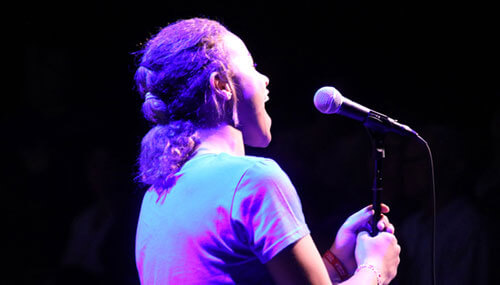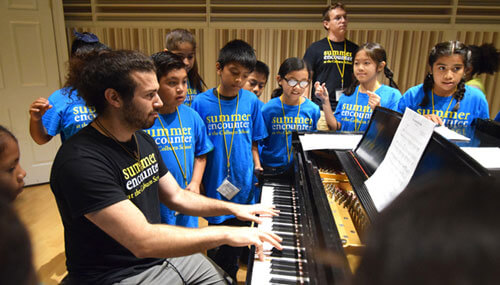East West Lifestyle
Making Kids Whole: The Necessity of Arts Education
By
How performing arts has changed lives and pushed kids towards a brighter future.
Slowly, the stage lights in the theater turn on to reveal over 50 children standing before the audience, all of them clad in blue T-shirts that proclaim “Summer at the Center” across the front in a bright yellow graphic. They stand in neat rows, bathed in a purplish light. The stage—which is actually just an open floor—butts right up to the first row of seats, so close that those sitting there can feel the nervousness and exhilaration of the young performers. After a beat, the band begins to play a lively Broadway number, and all 50-plus kids start singing and dancing in unison.
This performance is the culmination of an intensive two-week program called Summer at the Center, held every year for the past 26 years at Segerstrom Center for the Arts in Orange County, Calif. “It’s a program that is meant to serve the most high-risk youth in our community,” explains Talena Mara, vice president of education and community at the Segerstrom Center. The program usually accepts about 60 children and can be used as credit towards a GED. “These are students who have either left or been taken out of their public school, and have been placed in the ACCESS division of the Orange County Department of Education (OCDE), which are like small schools that students can go to on an altered schedule so that they can then graduate from high school,” she adds.
The Segerstrom Center is not alone in its efforts to bring the arts to those who need it: the Colburn School, a Los Angeles-based performing arts school, also puts on a similar program called Summer Encounter. As supporters of the arts and our communities, East West Bank has partnered with both organizations to sponsor their summer programs and provide greater access to excellent arts education for underserved children.

“The arts give us so many opportunities to do things differently. When those kids make that choice, they see how they can make other choices.”
The Colburn School partners with 16 schools in Southern California, and the program lessons are all taught by Colburn faculty. “The original thought behind the program was to open the doors of the Colburn School to the local community, to give children who otherwise wouldn’t have an opportunity to be engaged in the arts a two-week immersion in the performing arts,” says Nate Zeisler, director of community engagement and career development at the Colburn School. “I think the big goal of this program is we’re providing access in a diverse and inclusive way. It’s access to excellence, not access and excellence.”
The necessity of performing arts
Studies show that students exposed to an arts education have improved cognitive development (critical thinking, problem solving, etc.) and higher grades and test scores. Despite the positive impact the arts has on young students, access to it has consistently declined over the years, and most significantly for African-American and Hispanic populations. In California, budget cuts and a focus on standardized testing subjects have all contributed to the decline of public arts programs, despite California law saying that schools must provide music, art, theater and dance instruction at all grade levels.
“People think that the arts are somehow expendable,” says Mara. “In no way are the arts expendable in the school environment; they are very much part of every other subject. For some kids, they have trouble learning other subjects if it’s not through the arts door.”
Zeisler adds that the arts also play a big role in building soft skills that will ultimately help children once they enter the workforce. “It’s creativity, collaboration, grit and ‘stick-with-it-ness,’” he says. “It’s being able to live your life with empathy. These are the skills that are inherently built into the arts that students often miss if they don’t get that experience.”
The impact performing arts has on children
Summer at the Center targets high school-age kids who have struggled with various hardships in their young lives, ranging from drug and alcohol addiction, to involvement in gang activity. However, the one thing that binds them together is the desire to shift their lives to a new track. “The arts give us so many opportunities to do things differently,” shares Mara. “When those kids make that choice, they see how they can make other choices.”
Although privacy laws prevent the organization from knowing too much about their students, Mara shares that, in the future, they often receive word of the program’s impact on them. “We had one student who was here—it might’ve been in the very first year [of the program]. His name is Luis,” Mara says. “He had gotten in trouble as a kid and then came to Summer at the Center. Now he’s a full-grown adult with children of his own—and he’s a social worker. He works with kids who were just like he was. In fact, he works with some of the kids who have been to Summer in the Center in the past.”
"The belief that we hold at Colburn is that the arts make a person whole."

For the Colburn School, their main goal is to have the arts influence the lives or work of the students, and help them become successful in whatever track they pursue. However, the school also encourages Summer Encounter participants to apply to other Colburn School programs to continue their performing arts education.
“We’ve seen some kids come through the Summer Encounter program and then receive scholarships to keep studying,” Zeisler says. “The greatest sign of success for me is that they are successfully integrated and taking part in the day-to-day activities at the Community School of Performing Arts (the main part of the Colburn School). We have a few students who have come through and are now thriving through a program called the Herbert Diverse Scholars, which is a full tuition program for students performing at an intermediate level.”
The catalyst for change
Most of the kids participating in both Summer at the Center and Summer Encounter have little to no previous experience in performing arts—but it’s precisely that newness and unfamiliarity that makes these programs’ impact so powerful.
“When they come in, there’s so much to learn and they just sort of hit the ground running,” says Mara. “Starting something new that’s creative, feeling all the fear that goes along with it, feeling all the resistance—it’s overwhelming to think about. But we make a safe place where all that fear and resistance can be answered and addressed. We give them enough support that they hang on long enough to get through that fear. There comes this moment when they think, ‘I can’t do this,’ where if you help them push through that, they suddenly really open up and become more creative and engaged. They realize that they can do it.”
The power lies in the kids learning what hard work looks and feels like. Zeisler shares that, over the two weeks, the students actually work hand-in-hand with the faculty and counselors to script the Summer Encounter show—as well as perform in it. “One of the most invaluable pieces of being an artist is the idea that not everything is going to work out. It’s all about the artistic and creative process,” he explains. “There are things that are put in, and then taken out, and then put back in. Ultimately, it’s successful, but there’s not a direct line from that first day to the end performance.”
Zeisler adds that all these inherent factors of performing arts—the hard work, the need to be creative and collaborative—greatly enhances a child’s overall education. “The belief that we hold at Colburn is that the arts make a person whole,” he says. “Students going through a public education—especially in Southern California—are lacking a vital piece of their human development. We believe that the arts provide that, for all the reasons I mentioned.”
Subscribe to the Reach Further Newsletter
Get inspiring stories in your inbox every month.

